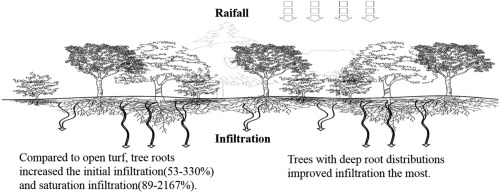当前位置:
X-MOL 学术
›
Urban Forestry Urban Green.
›
论文详情
Our official English website, www.x-mol.net, welcomes your feedback! (Note: you will need to create a separate account there.)
The effects of tree root density on water infiltration in urban soil based on a Ground Penetrating Radar in Shanghai, China
Urban Forestry & Urban Greening ( IF 6.4 ) Pub Date : 2020-04-01 , DOI: 10.1016/j.ufug.2020.126648 Changkun Xie , Shize Cai , Bingqin Yu , Lubing Yan , Anze Liang , Shengquan Che
Urban Forestry & Urban Greening ( IF 6.4 ) Pub Date : 2020-04-01 , DOI: 10.1016/j.ufug.2020.126648 Changkun Xie , Shize Cai , Bingqin Yu , Lubing Yan , Anze Liang , Shengquan Che

|
Abstract Urbanization often leads to soil compaction and reduces soil water infiltration rates which then increase runoff and flooding. Comparison of infiltration rates associated with tree root systems with different root distributions can help establish predictive models and improve species selection to mitigate runoff and flooding in urban environments. In Shanghai, 90 trees of 10 different species were scanned using a Ground Penetrating Radar. Soil properties were measured as well as the characteristics of the tree root systems, and their effects on infiltration were analyzed. Compared to the turf, tree roots increased the initial infiltration rate (53–330 %) and steady infiltration rate (89–2167 %). Trees with deep root distributions improved infiltration the most, followed by medium and shallow root distributions. Soil porosity and bulk density, the two most important factors that affect soil infiltration below 15 cm, became increasingly unfavorable to infiltration as the soil depth increased, which could be counterbalanced by the root systems. Relationship models of roots and soil infiltration in different soil layers were established to rapidly predict the infiltration of different tree species. Mixed planting of trees with different root distribution characteristics should be popularized, to ensure root systems develop at different soil depths, thus optimizing the infiltration effects of urban trees.
更新日期:2020-04-01



























 京公网安备 11010802027423号
京公网安备 11010802027423号